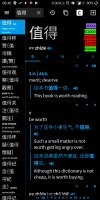maxiu
Member
Hi all, I have a question that is possibly wacky and probably has no answer, but it never hurts to ask 
I've used Pleco flashcards for years with great success. In fact, I'm such a big fan that when I started studying other languages and went looking for another flashcard app for them, nothing held a candle to Pleco. I then realized that there was really nothing keeping me from using Pleco for these other languages. I tried it out with Latin (love me some dead languages), putting the Latin word into where the Pinyin would normally be (the tone option even lets me signify long vowels, sweet). However here I ran into a problem - when I type a non-Pinyin word into the Pinyin box, it autocorrects it to Pinyin. Thus, "Agricola" (farmer) autocorrects to AgriCONGle, "aqua" (water) become aQUAN, "natura" (nature) becomes natuRAN, etc. No matter what I do it is intent on taking what I type and not-so-helpfully finding what Pinyin it thinks I'm trying to type. The only thing I've found that somewhat helps is sticking a dash or apostrophe in the middle to break it up, e.g. agric'ola, aq'ua, natur'a, etc, but this is annoying.
I know this is slightly ridiculous and I'm really stretching the limits of what the app is designed to do, but hey, be happy I like the app so much that I want to explore a novel use for it! Anyway, I was wondering if there was some way to turn this autocorrect off or some other kind of workaround? Like, barring the ability to directly turn it off, is there some non-Pinyin option to select where it isn't going to care what I type? Thanks!
I've used Pleco flashcards for years with great success. In fact, I'm such a big fan that when I started studying other languages and went looking for another flashcard app for them, nothing held a candle to Pleco. I then realized that there was really nothing keeping me from using Pleco for these other languages. I tried it out with Latin (love me some dead languages), putting the Latin word into where the Pinyin would normally be (the tone option even lets me signify long vowels, sweet). However here I ran into a problem - when I type a non-Pinyin word into the Pinyin box, it autocorrects it to Pinyin. Thus, "Agricola" (farmer) autocorrects to AgriCONGle, "aqua" (water) become aQUAN, "natura" (nature) becomes natuRAN, etc. No matter what I do it is intent on taking what I type and not-so-helpfully finding what Pinyin it thinks I'm trying to type. The only thing I've found that somewhat helps is sticking a dash or apostrophe in the middle to break it up, e.g. agric'ola, aq'ua, natur'a, etc, but this is annoying.
I know this is slightly ridiculous and I'm really stretching the limits of what the app is designed to do, but hey, be happy I like the app so much that I want to explore a novel use for it! Anyway, I was wondering if there was some way to turn this autocorrect off or some other kind of workaround? Like, barring the ability to directly turn it off, is there some non-Pinyin option to select where it isn't going to care what I type? Thanks!


